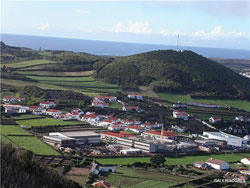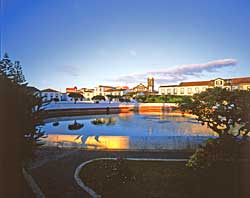|
|
|
|
|
|
Santa Cruz da Graciosa
The capital of the island, short called Santa Cruz, is easily explored by foot, as the few notable sights are mostly located near the tree-laden central square Praça Fontes Pereira de Melo, known to everybody as Rossio, and around the two adjacent water basins, which once served as water reservoirs for the inhabitants during drought periods. They have been transformed into decorative ponds, surrounded by pretty flower borders and small dragon trees. Not to be overlooked in this square is the somewhat outsized town hall with its three forged balconies. Only a few steps south of the square stands a lone bell tower, the only remains of a church that was torn down in the 20th century together with an adjoining Franciscan monastery, which had been left to decay after the expulsion of the monks. In the streets leading off the Rossio, many beautiful manor and town houses, reminding of the island’s wealth in the times of its thriving viticulture industry, can still be seen. East of the two ponds, still in the centre, are two churches dominating the town’s skyline: the Igreja da Misericórdia and the much bigger Igreja Matriz de Santa Cruz. The latter one, which is located a bit nearer to the sea, is the parish church. It was constructed in the 16th century, but renovated in the 18th century when it also received its present shape featuring three naves. Its white and black façade houses a remarkable gilded wood-carved main altar, with the altarpieces depicting Christ’s way of the Cross, as well as some beautiful glazed-tiles panels, the interruption in the sequence of its pictures documenting the later alterations to the church. The 16th-century Igreja da Misericórdia, also called Igreja do Santo Cristo due to an interesting figure of Santo Cristo dos Milagres in its high altar, has also an elaborate wood-carved main altar and some beautiful paintings. During the island’s most important religious feast, the Festa do Senhor Santo Cristo, at the second weekend in August, where also a tourada (bullfight) takes place, this church is the centre of all religious celebrations and its Christ figure is carried in a big procession through town.
North of the town hall, towards the seafront, lies the ethnographic Museu da Graciosa, which was opened in 1982 and boasts about 2,500 exhibits, spread over three sites. Many of the objects displayed in the main museum, were left behind by emigrants to the US and Canada and are often still in use in households in the countryside today. Especially to be mentioned is a collection of canes with elaborately carved knobs made of whalebones. Some of the rooms are dedicated to the winemaking process. The second part of the museum, the Barração das Canoas Baleeiros, a former whaling depot, can be found on the seafront, a couple of streets north of the main building. Here, an old whaler, some whalebones, radio receivers and flags give testimony of the time when whaling was still allowed off Graciosa’s shores. The Moinho de Vento, an old, renovated windmill, which is fully operational and can be visited on prior appointment, is located near the village of Fontes, south of Santa Cruz, and also part of the Museu da Graciosa.
|
|
|
|
|
|
|
|
|
|
Map of Graciosa
|
|
 |
|
Santa Cruz da Graciosa
|
|
 |
|
Santa Cruz da Graciosa
|
|
South of the centre, after a pleasant, about half-an-hour walk, you will reach the 130 m high Monte da Ajuda, a volcanic cone providing beautiful views over the town and the north coast. Spread around the semicircular crater rim are three chapels, among which the 16th-century Ermida de Nossa Senhora da Ajuda is the most noteworthy. Reminding of a small fortress on its outside, this chapel houses some beautiful 18th-century glazed-tiles panels. An annex building used to serve as accommodation for pilgrims and simple rooms can still be rented there today. The other chapels are the 16th-century Ermida de São João and the 18th-century Ermida de São Salvador. Below the three chapels, which form a sort of triangle, north of the Monte da Ajuda, the town’s bullring can be seen. Southeast of the centre, at the junction towards the old harbour Cais da Barra, stands the 16th-century Cruz da Barra, a noteworthy cross in the Manueline style.
West of Santa Cruz, between the airport and the tiny village of Dores, remains of the once thriving viticulture industry, the vineyards of the island’s most important vine-growing estate, protected by numerous dark basalt stonewalls, dominate the landscape on the north coast. Here, the Azores-wide known Terra do Conde wine is produced. At the coast lies Barro Vermelho, a popular picnic and bathing venue with a natural swimming pool, taking its name from the red clay in this area, which was used for pottery in former times. |
|